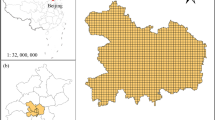Abstract
Seeking passengers is a kind of behavior of taxi drivers with clear purposes. They always need to make decisions on where to seek the next passenger after finishing a trip. Experienced drivers are capable to capture passenger source within a short time to reduce no-load time. Most of the existing literatures focus on simulating or analyzing movement patterns of taxi drivers. This research proposes a method of analyzing spatiotemporal characteristics of taxi drivers’ cognition to passenger source. Using a seven-day taxi trajectory data set collected in Beijing, an index CLPS is introduced to evaluate taxi drivers’ cognitive level to passenger source. Based on this, spatiotemporal distribution of top drivers’ cognition to passenger source is explored. The results of the research show that top drivers’ cognition to passenger source has obvious spatiotemporal distribution features. This research is expected to provide new ways for understanding human spatial cognition.
Access this chapter
Tax calculation will be finalised at checkout
Purchases are for personal use only
Similar content being viewed by others
References
Yamamoto, K., Uesugi, K., Watanabe, T.: Adaptive routing of multiple taxis by mutual exchange of pathways. Int. J. Knowl. Eng. Soft Data Paradigms 2(1), 57–69 (2010). https://doi.org/10.1504/IJKESDP.2010.030466
Gong, L., Liu, X., Wu, L., Liu, Y.: Inferring trip purposes and uncovering travel patterns from taxi trajectory data. Cartogr. Geogr. Inf. Sci. 43(2), 103–114 (2016). https://doi.org/10.1080/15230406.2015.1014424
Hu, X., An, S., Wang, J.: Exploring urban taxi drivers’ activity distribution based on GPS data. Math. Probl. Eng. 1–13 (2014). https://doi.org/10.1155/2014/708482
Zhang, Z., He, X.: Analysis and application of spatial distribution of taxi service in city subareas based on taxi GPS data. In: ICCTP 2011: Towards Sustainable Transportation Systems, pp. 1232–1243 (2011). https://doi.org/10.1061/41186(421)121
Gao, Y., Jiang, D., Yan, X.: Optimize taxi driving strategies based on reinforcement learning. Int. J. Geogr. Inf. Sci. 32(8), 1677–1696 (2018). https://doi.org/10.1080/13658816.2018.1458984
Zhao, L., Song, Y., Zhang, C., Liu, Y., et al.: T-GCN: a temporal graph convolutional network for traffic prediction. IEEE Trans. Intell. Transp. Syst. 1–11 (2019). https://doi.org/10.1109/tits.2019.2935152
Walker, G.H., Stanton, N.A., Young, M.S.: An on-road investigation of vehicle feedback and its role in driver cognition: implications for cognitive ergonomics. Int. J. Cogn. Ergon. 5(4), 421–444 (2001). https://doi.org/10.1207/S15327566IJCE0504_4
Dong, W., Liao, H., Roth, R.E., Wang, S.: Eye tracking to explore the potential of enhanced imagery basemaps in web mapping. Cartogr. J. 51(4), 313–329 (2014). https://doi.org/10.1179/1743277413Y.0000000071
Liu, L., Andris, C., Ratti, C.: Uncovering cabdrivers’ behavior patterns from their digital traces. Comput. Environ. Urban Syst. 34(6), 541–548 (2010). https://doi.org/10.1016/j.compenvurbsys.2010.07.004
Tang, L.L., Duan, Q., Kan, Z.H., Li, Q.Q.: Study on identification and space-time distribution analysis of taxi shift behavior. J. Geo-Inf. Sci. 167–175 (2017). https://doi.org/10.3724/sp.j.1047.2017.00167
Acknowledgement
This research was funded by National Natural Science Foundation of China (No. 41971355), the Open Project of State Key Laboratory of Resources and Environmental Information System and Yueqi Young Scholar Project of China University of Mining and Technology at Beijing.
Author information
Authors and Affiliations
Corresponding author
Editor information
Editors and Affiliations
Rights and permissions
Copyright information
© 2020 Springer Nature Switzerland AG
About this paper
Cite this paper
Wang, Z., Li, J., Zhu, Y., Li, Z., Lu, W. (2020). Analyzing Spatiotemporal Characteristics of Taxi Drivers’ Cognition to Passenger Source Based on Trajectory Data. In: Di Martino, S., Fang, Z., Li, KJ. (eds) Web and Wireless Geographical Information Systems. W2GIS 2020. Lecture Notes in Computer Science(), vol 12473. Springer, Cham. https://doi.org/10.1007/978-3-030-60952-8_9
Download citation
DOI: https://doi.org/10.1007/978-3-030-60952-8_9
Published:
Publisher Name: Springer, Cham
Print ISBN: 978-3-030-60951-1
Online ISBN: 978-3-030-60952-8
eBook Packages: Computer ScienceComputer Science (R0)




